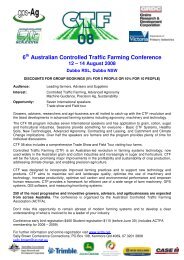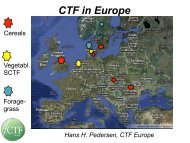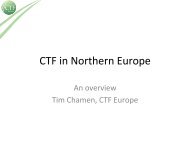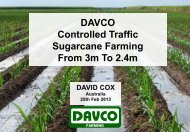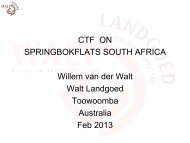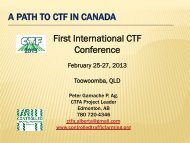Mark Wandel, Controlled Traffic Part Of The System - ACTFA
Mark Wandel, Controlled Traffic Part Of The System - ACTFA
Mark Wandel, Controlled Traffic Part Of The System - ACTFA
Create successful ePaper yourself
Turn your PDF publications into a flip-book with our unique Google optimized e-Paper software.
<strong>Controlled</strong> <strong>Traffic</strong> <strong>Part</strong> <strong>Of</strong> <strong>The</strong> <strong>System</strong><br />
<strong>Mark</strong> <strong>Wandel</strong>, Willawayup, Scaddan, WA.<br />
We are a family farming operation in the mallee region of Esperance Western Australia. <strong>The</strong> farm is in<br />
partnership with parents Neil and Mary <strong>Wandel</strong>, brother Scott and myself. We farm two properties of<br />
14800Ha, 10400Ha at Mt Ridley 350400mm rainfall and 4400Ha at Scaddan 425450mm Rainfall.<br />
All farms are continuously cropped. We also have a grain handling business in Esperance Esperance<br />
Quality Grains with 3500T of elevated storage with drying and cleaning facilities.<br />
I manage the Scaddan operation with my wife Hayley and our 3 children. <strong>The</strong> soil types are mainly<br />
loams through to grey clays with pH of 5.58.0 to a depth of 1030cm over clay. Cropping rotation<br />
consists of a standard rotation for our region of;<br />
Legume , Faba Beans , Feild Peas and vetch<br />
Wheat<br />
Canola<br />
Wheat<br />
Barley<br />
CONTROLLED TRAFFIC<br />
What started me thinking about controlled traffic was:<br />
Soil structure I could see damage from traffic especially in dry starts and clay soil types with<br />
poor crop establishment on traffic areas and good establishment on low traffic areas.<br />
I was noticing the good soil structure on the first 15ft of paddock where there was no traffic<br />
due to the fence and it getting worse with traffic, particularly the boom spray wheel marks that<br />
were obvious.<br />
Reading articles from eastern states on what they were achieving with the improved soil<br />
structure from controlled traffic.<br />
This got me thinking that there was a more efficient way than driving everywhere over the paddock<br />
and this system could give us improved agronomic opportunities knowing where every operation had<br />
occurred.<br />
I made the decision in 2003 that we had to start working towards a controlled traffic system because, I<br />
could see the longterm benefits that it would bring to our operation. We have been 100% notill<br />
seeding since 1994 and could see that controlled traffic as the next step to make the farm more<br />
productive and sustainable.<br />
PLANNING<br />
Our first step to adopting controlled traffic was to write down what machinery we had now and what<br />
we wanted to get in the future and worked from there. In 2003 I decided to go on a controlled traffic<br />
tour to QLD with DAFWA supported by GRDC which was excellent. <strong>The</strong> tour showed me that<br />
controlled traffic had to be implemented straight away because it works. We had a look at many<br />
different systems and gained lots of ideas<br />
So out came the graph paper and I was into it. In the end we came out with a 9 metre system on 3m<br />
wheel centres with 300mm row spacings. I practically started with the header and worked my way<br />
back from there. Our system that we have and are working towards is this;<br />
18m seeders 300mm row spacings<br />
27 and 36m boom sprays<br />
9m Header<br />
9m SP swather deck shift double up to 18m rows
9m wide row seeder and shielded sprayer want to go to 18meter<br />
9, 18m spreading width<br />
All on 3mwheel centres<br />
I think at the end of it all we had a choice of either 9meter or 12meter width system. We came to the<br />
conclusion that 9m was the best for us because;<br />
We wanted to run 18m seeders due to their efficiency<br />
We had self propelled sprayers on 3m and 27m boom widths already and wanted to go to 36m<br />
in the future<br />
Swathing, had a 9m SP swather and was concerned about making a neat<br />
swath with a 12m front<br />
Spread gypsum and lime and was concerned about getting an even spread at 12m and 24m for<br />
super.<br />
Can unload into chaser bin with both machines remaining on the tramlines<br />
Can increase the speed of the header 8090% of the time to compensate for the reduction in<br />
width, plan on growing more grain to keep them full.<br />
Had 9m flex fronts and 10.3meter draper fronts<br />
Concerned about the even distribution of straw across the paddock at a width of 12m thought<br />
9 m was more manageable<br />
Higher percentage of our machinery fitted the 9m system would have cost more to go to the<br />
12 m system in the short term.<br />
IMPLEMENTATION<br />
To implement the system we;<br />
Purchased a John Deere RTK base station and upgraded receivers to RTK<br />
Purchased 18m airseeder and bin on 3 meter centres<br />
Cotton Reels on JD 8520 and wound rear axels out<br />
Built 9m three point linkage toolbar for seeding and shielded spraying beans on wide rows<br />
Put 3m axel on spreader<br />
FARM PLANNING<br />
We were very lucky that all the blocks are north south in length and so we came up with the plan<br />
of having one set of run lines for the whole 4400ha at Scaddan on 180 degrees. This keeps it<br />
simple for operators, as there is no changing run lines between blocks and stuffing it up. Most of<br />
our laneways are east west through the farms which work out well for access and we drive over<br />
these during operations. We have realigned some of these to go directly east west.<br />
RESULTS<br />
We have been very happy with the results and improvements have occurred quicker than first<br />
thought. Some benefits are;<br />
<strong>The</strong> soil has become softer more even and easier to work<br />
Less horsepower and fuel is used to pull implements<br />
Increased soil water holding capacity<br />
Improved trafficability when wet<br />
Improved trash handling and crop establishment with inter row seeding<br />
Increased opportunities to control weeds<br />
Burn 18meter header trails tramlines help as fire breaks<br />
<strong>Controlled</strong> traffic has opened up many more opportunities in our system and I think there is a lot<br />
more to find. <strong>Controlled</strong> traffic has given us the opportunity to establish crops on less rainfall,<br />
given us the ability to do operations exactly were we want to do them to improve overall<br />
efficiencies.
PROBLEMS<br />
As with everything, everything has its problems, such as;<br />
Getting the old man’s head around it so it can all happen,<br />
Ryegrass in tramlines,<br />
Rutting and water pooling on heavy clay wet areas,<br />
Head land management,<br />
Trying to get everything to fit on tramlines with minimal expenditure,<br />
Swathing barley with the direction of seeding trying to stop it from collapsing in between the<br />
rows (used to go at 45degrees to seeding direction),<br />
Educating casual staff on what we are trying to achieve (don’t drive everywhere).<br />
We have tried to overcome some of these problems by:<br />
Ryegrass in tramlines fitting shields on to front of sprayer to knock out tramlines while<br />
spraying rest of paddock.<br />
Headlands in the process of setting up run lines on the headlands to have tramlines on<br />
headlands in every block.<br />
Swathing barley using inter row seeding to seed in between the previous years wheat stubble<br />
leaving that standing and undisturbed to use as a support to hold up the swaths.<br />
Rutting – keep driving straight through them (still working on this one).<br />
Educating casual staff – code of conduct explaining what happens.<br />
CONCLUSION<br />
Implementing controlled traffic has been interesting but rewarding transition in our farming<br />
system. I believe that it has improved our overall profability in the short and long term. It has<br />
created many opportunities not present before to improve our farming operation and production.<br />
Looking back on were we have gone in the last three years the key things that I believe are<br />
essential to making controlled traffic work are;<br />
Planning – right down to the row spacings and the guess row, think were you want to be in the<br />
future not were you are now. (Before you get the oxy out);<br />
RTK – Repeatability is the key word of controlled traffic;<br />
Applying – doing everything possible with what you have to get were you want to be in the<br />
shortest period of time.



